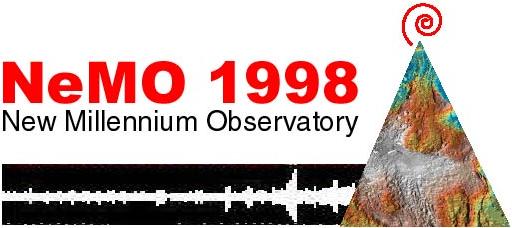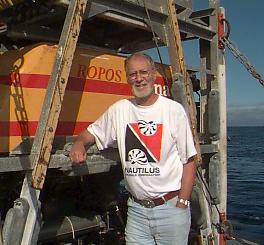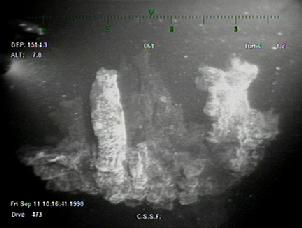WHAT'S NEW:
Eruption Confirmed!
New lava (rumbleometer stuck in flow) SE rift zone
(posted 9/1/98)
BACKGROUND:
Technology (ROV, ships, etc.)
Other 1998 Axial cruise reports
EXPEDITION:
Science Objectives
Calendar
Today's Science News
Participant Perspective
Teacher Logbook
EDUCATION:
Curriculum
Teacher Observations
Questions/Answers from sea
MULTIMEDIA:
(video clips, animations, sounds)

Logbook
September 11, 1998
September 11, 1998
Contents:
Science Report
Listing of all Science News postings
Life at Sea: Participant Perspective

Steve Scott
University of Toronto
ROPOS was slowly navigating over the rugged basalt in the caldera of Axial
Seamount when suddenly out of the gloom appeared a huge structure that looked
for all the world like a castle from a fairy tale, complete with spires and
battlements. The Castle (photos left & right), as we now call it, is a metallic sulfide spire that is
 being formed by the precipitation of minerals from hydrothermal ("hot water")
fluid. It is about 10 meters (33 feet) high, 3 meters (10 feet) in diameter at
its base but flairs out to 5 meters (17 feet) at its top. Festoons of 50-cm to
one-meter tall chimneys that look like small minarets occur around the peak
giving the castle-like appearance. As an ore deposits geologist, this is what I
had come to Axial Seamount to see and sample.
being formed by the precipitation of minerals from hydrothermal ("hot water")
fluid. It is about 10 meters (33 feet) high, 3 meters (10 feet) in diameter at
its base but flairs out to 5 meters (17 feet) at its top. Festoons of 50-cm to
one-meter tall chimneys that look like small minarets occur around the peak
giving the castle-like appearance. As an ore deposits geologist, this is what I
had come to Axial Seamount to see and sample.
 My name is Steve Scott. I am a geologist from Toronto, the
Canadian city of
back-to-back World Series baseball championships a few years ago and charging
for a wild card berth this year. In the early part of my career, I studied base
metal (you know -- copper, zinc, lead) and precious metal (silver, gold) ores on
land in Canada, the United States, Mexico, Europe, South Africa, Brazil and
Japan. For the past 18 years (ok, so I am a little older than most of the
scientists onboard), my students and I in the Scotiabank Marine Geology Research
Lab at the University of Toronto have been applying our knowledge of ore
deposits to the sea floor. We know that some types of ores that we are now
mining on land formed in oceans millions to even billions of years ago. We view
a site like Axial Seamount to be a natural laboratory for learning how such ores
are made. There are dozens of questions seeking answers. Where do the
hydrothermal fluids come from? What is their composition? How are the minerals
precipitated? Why do metallic deposits occur in some places but not others? What
is the composition of these deposits? Why is the composition different in
different geological settings? If we are successful in our research, we will
help develop new ideas for finding ore bodies on land. Some of the seafloor
discoveries may even become economic resources in the future.
My name is Steve Scott. I am a geologist from Toronto, the
Canadian city of
back-to-back World Series baseball championships a few years ago and charging
for a wild card berth this year. In the early part of my career, I studied base
metal (you know -- copper, zinc, lead) and precious metal (silver, gold) ores on
land in Canada, the United States, Mexico, Europe, South Africa, Brazil and
Japan. For the past 18 years (ok, so I am a little older than most of the
scientists onboard), my students and I in the Scotiabank Marine Geology Research
Lab at the University of Toronto have been applying our knowledge of ore
deposits to the sea floor. We know that some types of ores that we are now
mining on land formed in oceans millions to even billions of years ago. We view
a site like Axial Seamount to be a natural laboratory for learning how such ores
are made. There are dozens of questions seeking answers. Where do the
hydrothermal fluids come from? What is their composition? How are the minerals
precipitated? Why do metallic deposits occur in some places but not others? What
is the composition of these deposits? Why is the composition different in
different geological settings? If we are successful in our research, we will
help develop new ideas for finding ore bodies on land. Some of the seafloor
discoveries may even become economic resources in the future.
Mineral deposits of metallic sulfides, iron oxides, calcium and barium sulfates, silica and traces of gold are presently forming at many places on the ocean floor. The gold in samples analyzed from Axial Seamount average about 6 parts per million parts of rock by weight (ppm) -- not much but this is several times greater than the concentration of gold found as a by-product in base metals mines on land. The minerals are precipitated from heated seawater as it vents onto the sea floor. The process is a gigantic convection system. Cold (2 degrees C) bottom water percolates down faults several kilometers into the ocean crust where it is heated by magma, undergoes various chemical transformations, leaches metals from the lavas and, being hot so very buoyant, rushes back to the sea floor with its dissolved mineral load. The most dramatic product of this process is large spires, like Castle, spouting dark mineral-laden fluid from chimney-like structures at temperatures hot enough to melt lead and mixing turbulently with the ambient sea water. Castle is a dying system so the temperature of its hottest fluid is a little lower, around 270 degrees C.
Many such structures may be found in a given vent field. The hottest hydrothermal fluid of these "black smokers", so-called because they look like dirty industrial smoke stacks, is vented at several cm per second, has temperatures typically as high as 350 degrees C, and contains about 100 ppm of dissolved metals. A particularly robust black smoker can produce 500 tons of precipitates per year although most of this is lost into the overlying seawater as a particulate plume. Through time, the hydrothermal activity dies, as appears to be happening at Castle. The spires and chimneys collapse to build up a mound of rubble and new spires and chimneys grow repeating the cycle over and over. Eventually, a very large deposit is formed, such as one on the Mid-Atlantic Ridge that is the size of the Toronto Skydome ... or Houston Astrodome if you prefer.
The sea floor deposits may, themselves, be resources for the future both for their contained metals and perhaps also for their thermal energy -- a large black smoker has the same power output as a small nuclear reactor. Some seafloor deposits, although not those at Axial, are of sufficient size and apparent grade that, if they were on land, would attract the interest of the mining industry. In fact, an Australian company, Nautilus Minerals Corporation, holds the world's first exploration license for a marine metallic sulfide site that I had a hand in discovering in 1993 offshore Papua New Guinea in the western Pacific. Ocean mining of metallic sulfides will inevitably follow oil production into the deep ocean. We marine scientists are in the forefront of establishing environmental guidelines for this activity.
All of this new, almost futuristic, activity should not surprise us. After all, in 1870, Captain Nemo in Jules Verne's classic book Twenty Thousand Leagues Under the Sea said (translated from the original French): "On the ocean floor there are mines of copper, lead, silver and gold that would be easy to exploit". Maybe there is something to be learned from science fiction.
Want to know more? Send me a message via this web site (oar.pmel.vents.webmaster@noaa.gov) or check out my lab's site at www.geology.utoronto.ca/marinelab. Thanks for tuning in.
Listing of all Perspectives postings
Teacher At Sea Logbook
September 11 - 1000 hours
There has been a request to hear what people do on board ship when they are not doing oceanography. As I was thinking about how to answer that question I realized that I had not stepped out on to the deck and looked at the ocean or breathed fresh air in about 48 hours. This job is like most jobs. You end up wondering where the time went. The big difference out here is that your world is only 275 feet long and 50 feet wide and is shared by 58 other humanoid biological units. As I indicated in a previous posting, people are up and working 24 hours a day. As I write this, about one-third of the crew and science staff are asleep. Very few of us get to maintain anything close to a normal wake/sleep cycle. For the scientists, waking and sleeping are dictated by ROPOS. If the sub is down there are jobs that have to be done to keep it working properly and there are jobs that make sure that everything we see is documented in quadruplicate. If the sub is up, there are samples for virtually everyone on board. With two or three hours of sleep, scientists come to the lab to process fresh samples. The hours just after ROPOS comes to the surface are among the busiest of the day.
With that kind of work schedule, people take their recreation where and when they can. Often it is just a quick catnap in a chair. Even with all the people on board it is surprisingly easy to find solitude. A lot of books get read during a voyage like this one. I am currently reading Sherman Alexie's Reservation Blues, and Tom Clancy's Politika simultaneously. I never like to read just one book at a time.
Another place you can generally find solitude is in the ship's workout room. I was surprised to find Lifecycles, a rowing machine, weight benches and a variety of other exercise equipment in a small room deep inside the hull of the ship. Most people find time to work out two or three times a week. The ship also has a small library. There is a year's worth of paperback novels waiting for anyone who forgot to bring reading material. With something like 50 computers on board, you can believe that there is a wide variety of computer games for those addicted to such pursuits. We have everything from solitaire to bloody shoot-'em-ups.
There are also shared forms of recreation aboard. One of the most popular is the movies. We have literally hundreds of movies on board. Regular showtimes are at 1730 and 2000 hours, but other movies are run any time of the day or night. I generally see about three movies a year. I've seen about three year's worth already, and I have a week to go. There are also pickup card games at irregular intervals. Cribbage, hearts and spades are the most popular games. I got into a good hearts game with a bunch of graduate students two nights ago.20 There is an old saying something to the effect of, "Old age and treachery will defeat youth and exuberance every time." It's true, although playing hearts at 0100 hours tends to put the emphasis on the "old age."
For sports enthusiasts, we get Armed Forces Radio beamed to the ship. There is generally at least one baseball game or football game each day. I actually got to listen to much of the beloved Washington Huskies in their opening game. I gave it up with two minutes to go in the game when the Dawgs let ASU score on a 4th and 8 desperation pass. It's going to be a looooooong season.
One thing none of us has to worry about out here is whether or not we will be well fed. There are three meals served each day on a regular schedule. And snacks are available at all hours. The menus have been varied and outstanding. Some of our group are vegetarians. They find a variety of pastas, salads, fruits and desserts to keep them satisfied. The omnivores among us have also come away from the table satisfied. As examples, we have been served lobster three times, had a Mongolian barbecue, and had deep dish lasagna. There are invariably several choices of main dish. The other night I came to dinner, unfortunately not very hungry. It was "surf and turf" night. Loads of huge sauted prawns and a T-bone steak grilled to individual order. I passed on the steak, but the prawns were outstanding. The head steward is the oldest staff member on board. At 62, he has had years of experience preparing meals at sea, and the experience shows.
As you can see, it's not all work out here. Still for most folks, recreation comes in small doses. My colleague, Susan Merle, just told me she has read no books and seen no movies since coming aboard. The majority of her recreation has been three games of cribbage. I was the opponent for those three games. Old age and deceit took a severe beating that evening.
Tomorrow I will make a quick visit to labs for an update on what we have accomplished. ROPOS will go back in the water later today. Several hours of Imagenex mapping are planned, as well as collection of samples at some additional vent sites. Early in the dive scientists will be taking step one in an effort to recover the trapped rumbleometer. Stay tuned for the continuing saga of the quest for data recovery.
Logbook of all Teacher At Sea postings
Question/Answer of the Day
Send Your Question to NeMO
(oar.pmel.vents.webmaster@noaa.gov)
Back to Calendar